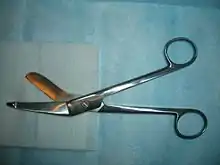Surgical scissors
Surgical scissors are scissors specially manufactured as surgical instruments, typically used for cutting sutures, dressings, and cutting and dissecting biological tissue.[1][2] Surgical scissors are usually made of surgical steel. Some have tungsten carbide reinforcements along their cutting edges, the hardness of which allows manufacturers to create sharper and more durable edges.
Mechanical types of scissors
There are two main mechanical types of scissors used in surgery:
- Ring scissors, which look and function much like standard utility scissors with ring finger loops
- Spring forceps are small scissors used mostly in eye surgery or microsurgery. The handles end in flat springs connected with a pivot joint. The cutting action is achieved by pressing the handles together. As the pressure is released, the spring action opens the jaws.
Scissors are available in various configurations like
- Blunt/blunt blades
- Blunt/sharp blades
- Sharp/sharp blades
Examples
Some examples of surgical scissors include:[3]
- Bandage scissors
- Dissecting scissors
- Iris scissors
- Suture scissors
- Tenotomy scissors
- Metzenbaum scissors
- Plastic surgery (facelift) scissors
- Mayo scissors
Gallery


 Bandage scissors
Bandage scissors Spring forceps scissors
Spring forceps scissors
See also
- Trauma shears
- Bandage scissors
- Hemostat, a surgical clamp resembling scissors
- Needle holder, an instrument resembling scissors used to hold a suturing needle
References
- Visenio, Michael (2019-03-26). "Commonly Used Surgical Instruments". facs.org. Retrieved 2022-02-23.
- Joanna Kotcher Fuller; Joanna Ruth Fuller (2012). Surgical Technology: Principles and Practice. Elsevier Health Sciences. p. 234. ISBN 978-1-4557-2506-9.
- "Instrument Handling: Scissors | UW General Surgery Technical and Professional Skills". sites.uw.edu. Retrieved 2022-02-23.
This article is issued from Wikipedia. The text is licensed under Creative Commons - Attribution - Sharealike. Additional terms may apply for the media files.